One of the last episodes of the war in North Africa, after the Axis forces had given up the initiative, the campaign entered its conclusive phase.
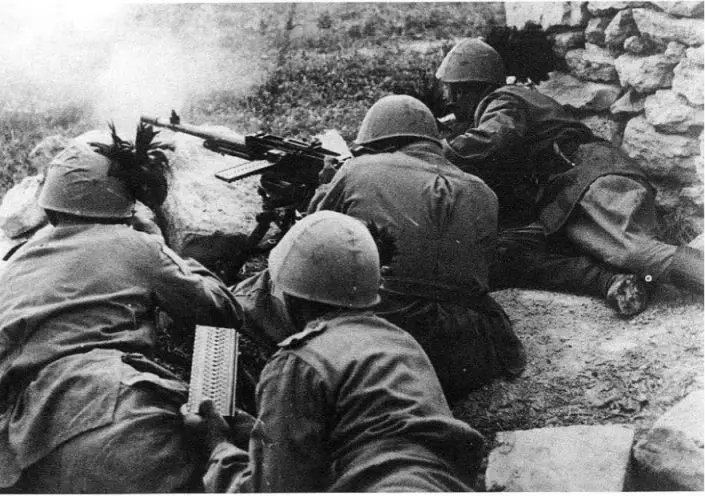
In mid-March 1943, after the offensive punches of the previous weeks, which had gained very little, Axis forces in Tunisia were getting ready for the next Allied offensive, this time targeting the defensive positions on the Mareth line. In this southern sector, the 1st Italian army (although mixed with German units) under General Giovanni Messe, faced south-east the British 8th army, with the sea covering the left flank and the Matmata hills covering the right flank.
From north to south, the 1st army deployed the following units:
XX corps (General Taddeo Orlando)
- Giovani Fascisti division (Italian) with 7 infantry battalions, 5 artillery groups, and supporting units.
- Trieste division (Italian) with 6 infantry battalions, 5 artillery groups, and supporting units.
- 90°light division (German) with 6 infantry battalions, 3 artillery groups and supporting units.
XXI corps (General Gavino Pizzolato)
- Spezia division (Italian) with 6 infantry battalions, 5 artillery groups and supporting units, including the Tobruk battalion of San Marco Marines.
- Pistoia division (Italian) with 6 infantry battalions, 4 artillery groups, and supporting units.
- 164° division (German) with six infantry battalions and no artillery.
These two corps garrisoned the defensive emplacements of the Mareth line while the Centauro division (now depending on the 1st army) was far in the rear, near Gafsa, guarding against any possible American attacks. The army reserves included the 15° Panzer Division and the 19° Flak Division. We mentioned that the right flank was in theory shielded by the almost impassable Matmata hills, however, a passage existed on the northwest end of the hill chain near El Hamma, which potentially threatened the rear of the Army.
General Messe deployed the Raggruppamento Sahariano to guard the passage, this was a mixed unit consisting of 6 infantry battalions, six artillery groups, and supporting units.
On the opposite side, Montgomery planned to launch a frontal assault against the Mareth line, which aimed to attract the axis mobile reserves. At the same time, a consistent force gathering New Zealander and French forces supported by tanks, had to cross hundreds of kilometers to the northwest, running parallel to he Matmata hills. Their objective was to reach the passage guarded by the Raggruppaento Sahariano and penetrate the rear of the 1st Army.
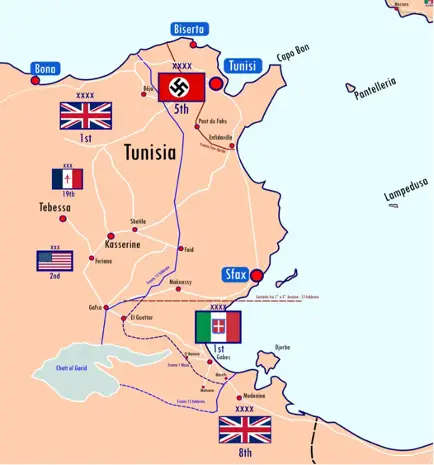
Axis forces in Tunisia 15 February- 1 March
Operation Pugilist
On the 20th of March, the 8th Army would have started the operation against Messe’s Army, but a few days before, elements of the 2nd American Corps advanced towards Gafsa and El Guettar, to threaten the Axis rear. The Centauro division withdrew, fighting small-dealing actions since it had not enough strength to stop the advancing enemies. Fearing Axis counterattacks, the Americans advanced slowly and after the 18th march, their movements were halted by heavy rains.
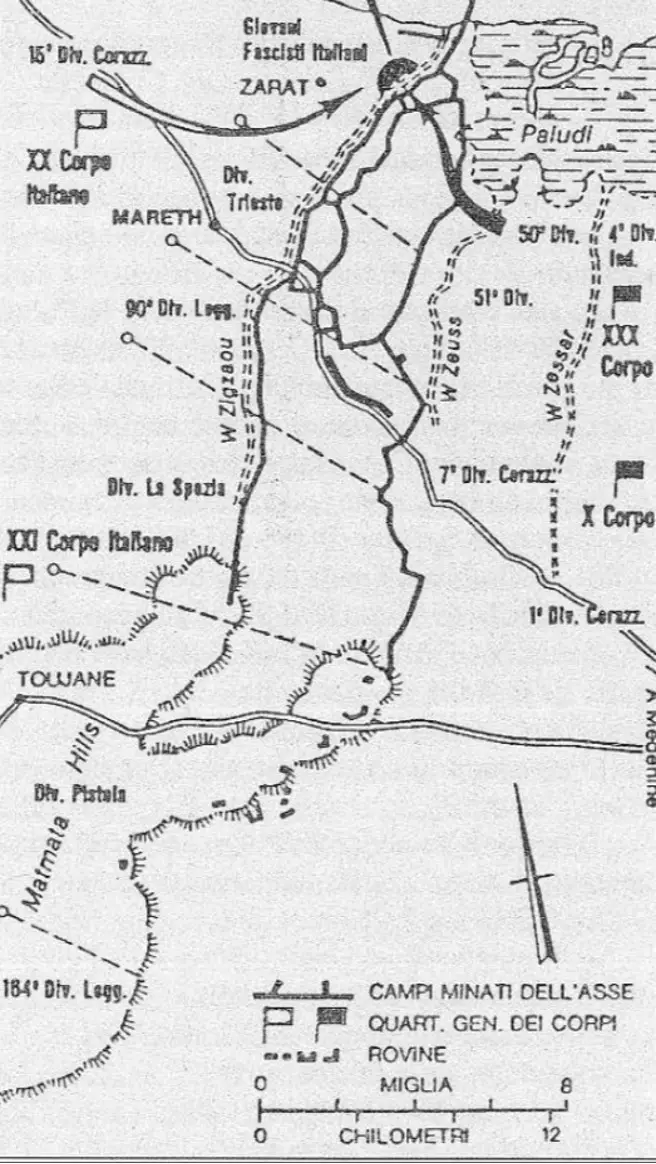
Operation Pugilist on the Mareth line
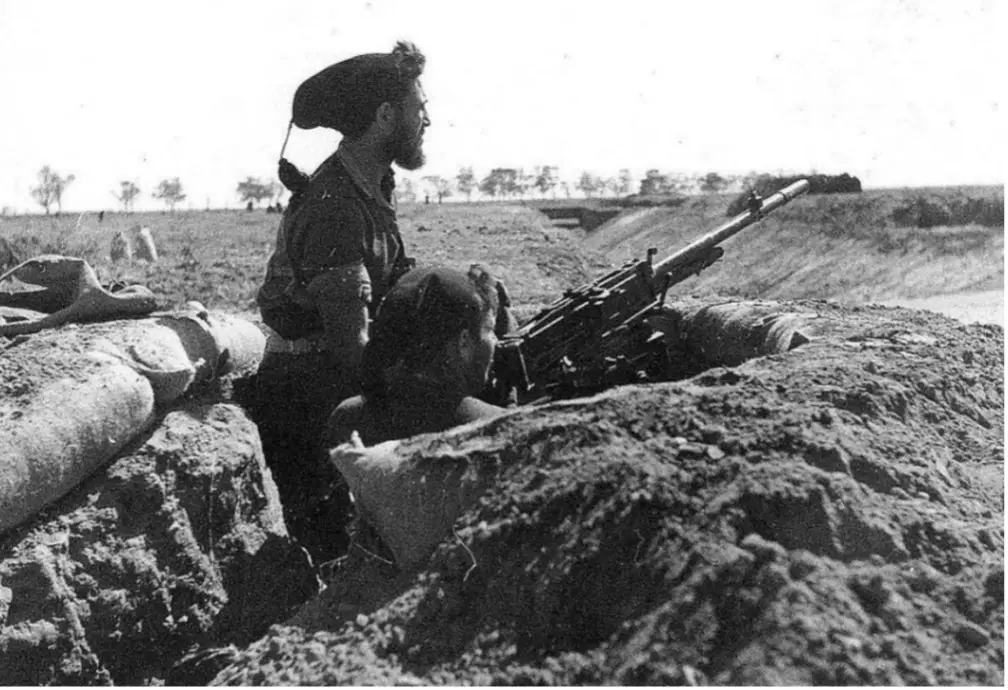
A position of the Giovani Fascisti division
To the south, the 8th army launched the assault against the advanced Axis positions before the Mareth line on the 16th of March. Between the 16th and 20th of March, the 50° and 51st British infantry divisions eliminated the forward positions of the Giovani Fascisti division, in the northernmost sector of the front.
The British assault managed to create a small bulge into the lines of the Giovani Fascisti but the attack was seen as the most worrying thing by Messe. He sent in the 15th Panzer to counterattack and by the 23rd March, the British infantry had withdrawn.
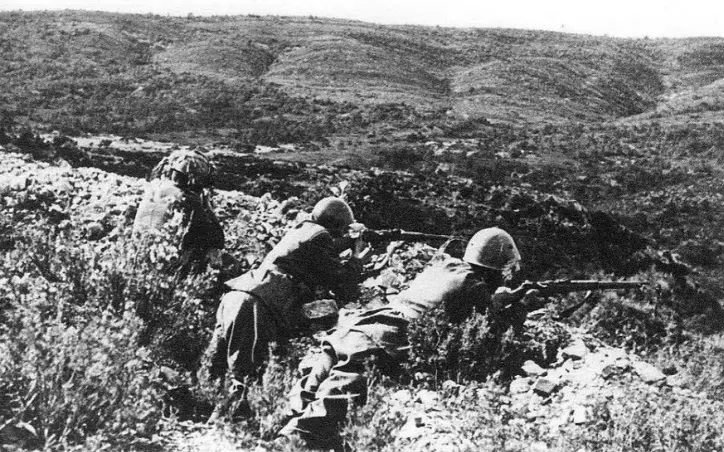
Italian infantrymen garrisoning the Mareth line
What really concerned the Italian General was the movement of the Armoured column towards the passage near El Hamma. Von Arnim sent the 21st Panzer south, to reinforce the reserves and possibly intervene at El Hamma with the Raggruppamento Sahariano. Already on the 21st, New Zealander and French forces under General Freyberg began their attack through the first of the passages in the hills, known ad the Tebaga gap.
In the following two days, no significant breakthrough had been achieved, the Saharina group, reinforced by the 21st panzer and the 164° division had contained the allied attack. With the Tebaga gap still closed and the setbacks on the Mareth line, Operation Pugilist was called off and Montgomery quickly re-arranged a new plan.
Operation Supercharge II
While the 8th Army was re-organizing for the next assault, the pressure from the American Army Corps of General Patton was increasing, and the counterattacks of the 10th Panzer Division had gained very little. Von Arnim considered that if the Americans had further advanced, the 21st Panzer division should have been recalled north but then the Tebaga would have been doomed. Von Armin talked with Messe about this dire situation and overall agreed to progressively withdraw from the Mareth line and bring the 1st Army to a new defensive position along the Wadi Akarit. The withdrawal started on the evening of the 25th of March while the Tebaga gap and the El Hamma positions in the rear had to be defended to allow the rest of the army to reach the new positions.
On the other side, Montgomery sent the 1st Armored Division to reinforce the New Zealanders corps, and a new attack was scheduled for the 26th of March, preceded by a heavy aerial bombardment. To the south, the 4th Indian division began a flanking movement through the Matmata hills, towards the former positions of the 164° division, now held by the Pistoia division.
On the 26th, Operation Supercharge II began in the Tebaga gap, inflicting heavy losses on the defenders, especially the Raggruppamento Sahariano and the 164° division. In the following two days, the Axis defenders withdrew towards El Hamma, doing everything they could to delay the enemy’s advance. This objective was achieved, and when Messe communicated that the bulk of the 1st Army had completed the withdrawal to the Wadi Akarit line, the last German defenders of El Hamma, with scattered remnants of the Raggruppamento Sahariano, pulled off too.
The Battle of Mareth was over and left some dissatisfaction in the field of the 8th army since it took quite some time and failed to destroy Messe’s army. However, another battle was about to take place soon, and the days of the Army Group Africa were counted.
Sources
Ford, K. (2012) The Mareth line 1943, Osprey publishing
Montanari, M. (1989). Le operazioni in Africa settentrionale, Volume IV: Enfidaville (Parte prima). Roma: Ufficio storico dello stato maggiore dell’esercito.
Jowett, P. (2019). L’esercito italiano nella seconda guerra mondiale. LEG edizioni.